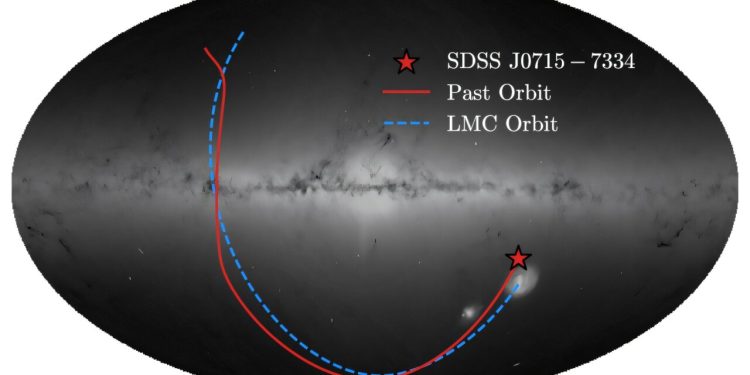
Kinematic properties. The past orbit of J0715 − 7334 and the LMC in galactic coordinates in the sky, superimposed on the distribution of all stars observed by Gaia.
Not all stars are created equal. Astronomers believe that the first stars to form after the Big Bang were mostly made only of hydrogen and helium with traces of lithium, because the heavier elements formed later through nuclear fusion inside the stars. When these stars went supernova, heavier elements spread into space and formed more stars. Each successive generation contained heavier elements, and these elements also became successively heavier.
While most stars still contain primarily hydrogen and helium, they now also contain many heavy elements, especially as they age. These features appear in spectrographic data when astronomers collect light from these distant stars. Stars are considered “pristine” when the data shows a lack of heavy elements, meaning they are likely very rare, older stars from previous generations. And now a group of astronomers, led by Alexander Ji of the University of Chicago, believe they’ve found the most pristine star ever recorded. The group documented its findings on arXiv preprint server.
The star, called SDSS J0715-7334, is a red giant believed to have the lowest metallicity (or heavy element content) ever found. The team’s detailed spectral and chemical analysis shows that SDSS J0715-7334 has a total “Z” metallicity of less than 7.8 x 10.-7. This is compared to the next lowest metallicity star currently known, a star located in the Milky Way with a total metallicity of approximately 1.4 × 10.-6.
“This is about twice as metal-poor as the previous record holder, J1029+1729 (Z -6). It is more than ten times as metal-poor as the most iron-poor star known, SMSS J0313-6708,” the study authors say.
But this star is not only lacking iron. SDSS J0715-7334 also contains a surprisingly low amount of carbon. Even other stars documented as having very low iron content still contained a fair amount of carbon, making this newly discovered star even rarer.
The group says the chemical model of SDSS J0715-7334 suggests it formed from gas from a supernova of a 30 solar mass Population III star – “Population III” stars being the first stars to form after the Big Bang.
“The detailed chemical abundances of the most metal-poor stars can be related to the properties of metal-free Population III stars through models of supernova nucleosynthesis. J0715−7334 is a particularly clean probe of Population III, because its distant halo orbit completely excludes any significant contamination of the surface by the interstellar medium and its large convective envelope eliminates any effects of diffusive sedimentation”, explain the authors of the study.
The researchers used kinematic analysis to trace the star’s origin to the Large Magellanic Cloud (LMC) using Gaia data and orbital modeling. The analysis indicates that it was originally part of the LMC and later migrated to the Milky Way.
While this discovery offers insight into the universe’s earliest stars and the origin of heavier elements, the data on J0715−7334 also provides answers to how stars cool. The team notes that J0715−7334 is now the second star below what’s called the “fine structure cooling threshold,” which describes how some gas clouds cool more quickly with heavier elements releasing more energy. The team says this work indicates that cosmic dust-assisted cooling – or dust cooling – is necessary to cool gas clouds enough to form low-metallicity stars at this threshold, and also occurs in galaxies beyond the Milky Way.
Written for you by our author Krystal Kasal, edited by Gaby Clark, and fact-checked and edited by Robert Egan, this article is the result of painstaking human work. We rely on readers like you to keep independent science journalism alive. If this reporting interests you, consider making a donation (especially monthly). You will get a without advertising account as a thank you.
More information:
Alexander P. Ji et al, An almost virgin star in the Large Magellanic Cloud, arXiv (2025). DOI: 10.48550/arxiv.2509.21643
Journal information:
arXiv
© 2025 Science X Network
Quote: Astronomers discover the most “pristine” star in the known universe (October 8, 2025) retrieved October 8, 2025 from https://phys.org/news/2025-10-astronomers-pristine-star-universe.html
This document is subject to copyright. Except for fair use for private study or research purposes, no part may be reproduced without written permission. The content is provided for informational purposes only.









